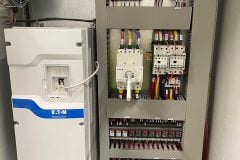Describing the generator’s soul
When specifying generators, the first thing that comes to mind is a rating. The machine’s rating is a set of parameters that, simply speaking in engineering terms, describe the generator. These values indicate the generator’s available power output as well as its capability in terms of electrical, thermal, and mechanical constraints.

With enough practice, a qualified person can frequently deduce further information regarding the generator’s size and basic design aspects.
The most common way to describe a generator is to assign it a rating. The generator’s rating is supplied at the machine’s maximum continuous power output capability point. Each of the below parameters is a design quantity that describes the generator’s capabilities or limitations. In some situations, they also specify operational restrictions that, if exceeded, will result in excessive stress on one or more of the generator’s components (mechanical, thermal, or electrical).
These parameters and some others not mentioned here (stator/rotor winding insulation and temperature class, overspeed capability, etc.) are considered in the design of all major generators, and they are all represented in the design standards for generators.
Currently, gas-turbine generators with ratings of up to 400-500 MVA are being developed. Currently, steam-turbine generators with ratings of up to 1700 MVA are being produced, but there are designs with ratings of up to 2000 MVA.
Figure 1 – Trend in MVA rating of large turbogenerators


The below-listed parameters have precise ranges that are outlined in design specifications and discussed in publications about proper operating practices for large generators.
The following are the terms commonly used to indicate the rating:
- Apparent power (in MVA, or Mega volt-amperes)
- Real power (in MW, or Megawatts)
- Power factor pf (dimensionless quantity) and Reactive power (in MVARs, or Mega volt-amps reactance)
- Stator terminal voltage Vt (alternating voltage)
- Stator current Ia (alternating current, in amperes)
- Field voltage Vf (direct voltage)
- Field current If (direct current, in amperes)
- Speed rpm (revolutions per minute)
- Hydrogen pressure psi (pounds per square inch)
- Hydrogen temperature (°C)
- Short-circuit ratio
- Volts per Hertz and Overfluxing
1. Apparent Power
The rating of a turbine generator is referred to as apparent power. It is generally always indicated in mega-volt-ampere (MVA) units in big generators, though it can alternatively be stated in kVA. Although real power (usually always expressed in megawatts [MW], though it can also be expressed in kilowatts [kW]) is commonly used to describe equipment, it is the apparent power that better represents the rating.
This is because the physical size of a machine is mostly determined by the product of voltage and current (MVA). The MVA in a three-phase power system is calculated using the following formula:
- MVA = √3 (Generator’s line current in kA) × (Line voltage in kV), or
- MVA = 3 (Generator’s line current in kA) × (Phase voltage in kV)
Also, MVA = MW / Power factor
Figure 2 depicts an example of a nameplate that might be placed on a large generator.
Figure 2 – Steam turbine power generator nameplate


Go back to the Contents Table ↑
2. Real Power
The product of the generator’s rated apparent power (in MVA) and rated power factor is the rated power (in MW). The rated power of the turbogenerator as a whole is determined by the turbine. To take advantage of additional output that may become available from the turbine, boiler, or reactor, the rated power of the generator is frequently set and constructed to be slightly higher than that of the turbine.
This parameter is measured and monitored in order to maintain track of the machine’s load point and to allow the operator to adjust the generator’s functioning.
Transient MW events from the system or internally in the machine will also show up as transients in the stator current and/or terminal voltage.
Suggested course – Electrical Machines Course: DC, Synchronous and Induction Machines and Transformers
Electrical Machines Course: DC, Synchronous and Induction Machines and Transformers
Go back to the Contents Table ↑
3. Power Factor
It was shown in many previously published articles, that the power factor is a measure of the angle between the current and the voltage in a particular branch or a circuit. In mathematical terms, the power factor is the cosine of that angle. Within the context of a generator connected to a system, the power factor describes the existing angle between the voltage at the terminals of the generator (Vt), and the current flowing through those terminals (I1).
The angle between the current and the voltage is characterized as positive in the workings of generators when the current lags behind the voltage, and negative when the current leads behind the voltage. As a result, the power factor is used to characterize whether the generator is “lagging” or “leading” in terms of power factor.
Premium Membership Required
This technical article/guide requires a Premium Membership. You can choose an annually based Plus, Pro, or Enterprise membership plan. Subscribe and enjoy studying specialized technical articles, online video courses, electrical engineering guides, and papers. With EEP’s premium membership, you get additional essence that enhances your knowledge and experience in low- medium- and high-voltage engineering fields.
Check out each plan’s benefits and choose the membership plan that works best for you or your organization.










